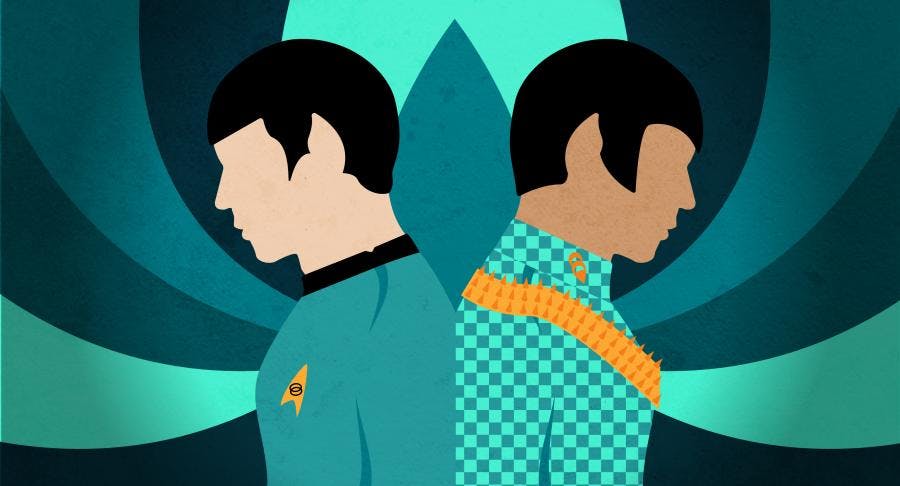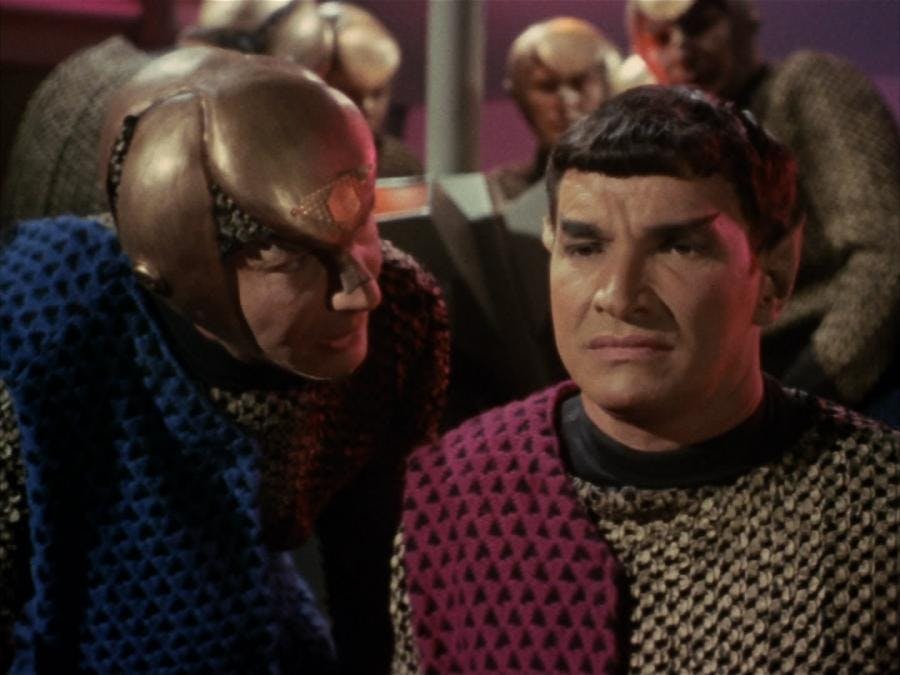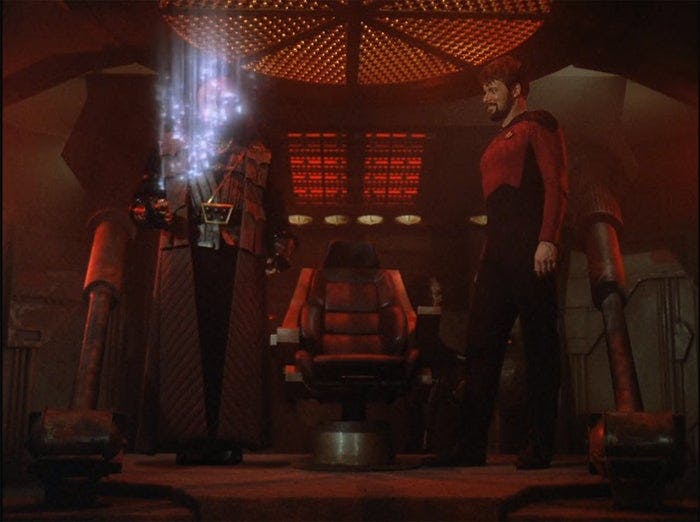Published Nov 4, 2022
Vulcans and Romulans: A Primer on Unification
Exploring one of the most crucial schisms in the Star Trek universe.

StarTrek.com
A couple of weeks ago, Jake Black wrote an excellent article about how Spock’s dream of Vulcan and Romulan unification, as shown in The Next Generation episodes “Unification, Parts I and II,” is incredibly relevant for the divided society we are today. But what, exactly, is unification, and why is it important to the Star Trek universe? I’m going to explore that in this primer on unification between the Romulans and Vulcans.

StarTrek.com
The Romulans and Vulcans descend from the same ancestor species — specifically, the Romulans are an offshoot of ancient Vulcans. From the Star Trek history we know, it’s unclear when the split between the two occurred, but it was likely during Vulcan’s war-torn period of history. Before they established logic as the foundation for their culture and history, Vulcans were similar to humans — emotional and warlike. They thrived on colonialism and conquest, establishing a large swath of colonies across space. Eventually, their empire fell and their society devolved into chaos.
Few records survive from this unstable time, so it’s unclear how the Romulan species was born, but they likely were established during this period. It’s possible that a faction of warlike Vulcans rejected the idea of peace and left to found their own civilization. It’s also possible that the Romulans are one of Vulcan’s outlying colonies that were abandoned by the homeworld and forgotten in the chaos. Either way, for centuries Vulcans were aware of the Romulans as an alien race, but had no idea that the two species shared an ancestral history.
In The Original Series episode “Balance of Terror,” the Enterprise encounters an unknown vessel (presumed to be Romulan) destroying Federation outposts along the Romulan neutral zone. Humans and Romulans had fought a vicious war in the past, but it was before viewscreens were common on ships and there were no captives taken during the conflict. As a result, no one had seen a Romulan in generations, and it was unclear what they looked like. Spock expressed real surprise that the species looked so similar to Vulcans and posited that the two had split during a violent period of Vulcan history, and that Romulans retained that warlike culture, while Vulcans had turned to logic.

StarTrek.com
Whenever the schism between the two species happened, it was long enough ago such that significant genetic differences have since evolved between Vulcans and Romulans. So while they have the same ancestors, the differences between them by the 24th Century, when The Next Generation is set, are deeper than just culture.
The pro-unification underground goes much further back in history than The Next Generation episode of the same name, where it was introduced. In Star Trek: Enterprise’s “Kir’Shara,” which aired after TNG but chronologically took place before The Original Series, a secret Romulan agent posing as a Vulcan mentions the unification movement to a Vulcan collaborator (no Starfleet officers were present at this exchange, hence why their shared past remained a mystery). While its origins are unclear (and we don’t know whether Romulan culture retained the memory of their genetic history), the movement was apparently thriving long before it was first depicted on screen.
In “Unification, Parts I and II,” which brought Spock to The Next Generation, the revered ambassador is spotted on Romulus, and the Federation fears that he defected. The costs of his betrayal would be incalculable, so they send Captain Picard on a mission to uncover what’s happened. After a visit to Sarek, Spock’s ailing father, Picard and Data head to Romulus aboard a cloaked Klingon Bird of Prey.
They discover that Spock has not defected; instead, he’s been working with an underground movement to support the reunification of Romulans and Vulcans. Many members of the group had been declared enemies of the Romulan state because of their adherence to Vulcan philosophy; Spock’s goal was to both help them and also evaluate the greater potential of reunification, though, he admits the possibility may be unlikely.
Over the course of the episode, Spock is betrayed by his closest Romulan ally, Senator Pardek, and he, Picard, and Data are captured by the Romulan government. It turns out that the Romulans are interested in reunification, but one at gunpoint — they want to invade Vulcan and conquer it. (As an aside, the idea of the Romulans being able to successfully invade one of the founding worlds of the Federation with three ships and 2,000 troops is laughably arrogant.)

StarTrek.com
Spock, Picard, and Data manage to escape, but the ambassador chooses to remain on Romulus. He recognizes that unification won’t happen via political channels, but instead through the will of the Romulan people, and he wants to help shepherd it. He stays on Romulus for at least a few years, as the sixth-season episode “Face of the Enemy” once again confronts unification.
While Spock himself isn’t in this episode, his fingerprints are all over it. Counselor Troi is kidnapped by Romulans and altered to look like one of them. She pretends to be a member of the feared Tal Shiar, the Romulan secret police, and her job is to successfully transport high-ranking members of the Romulan government to the Federation as defectors. Spock and his associates are hoping to open a new path for Romulan dissidents to leave the oppressive Star Empire.
What we know about unification after this point is negligible. In the Kelvin universe, at least, Spock continued working with the Romulans in some capacity, as he was involved in efforts to prevent their sun from going supernova. In the time of Star Trek: Picard, the Romulans are scattered, without a home world. It’s unclear whether the movement continued when so many of their brethren were lost, but unification, and the desire to connect with one another, is an important part of Star Trek history that shouldn’t be forgotten.
A Closer Look at Romulans
This article was originally published on November 24, 2020.
Swapna Krishna (she/her) writes about tech, science, and sci-fi. She’s a contributing editor at SYFY FANGRRLS and has been published at Engadget, Gizmodo, Mental Floss, the Los Angeles Times, and more. You can find her on Twitter @skrishna.
Star Trek: Picard streams exclusively on Paramount+ in the U.S. and is distributed concurrently by Paramount Global Content Distribution on Amazon Prime Video in more than 200 countries and territories, and in Canada it airs on Bell Media’s CTV Sci-Fi Channel and streams on Crave.
Stay tuned to StarTrek.com for more details! And be sure to follow @StarTrek on Facebook, Twitter, and Instagram.

